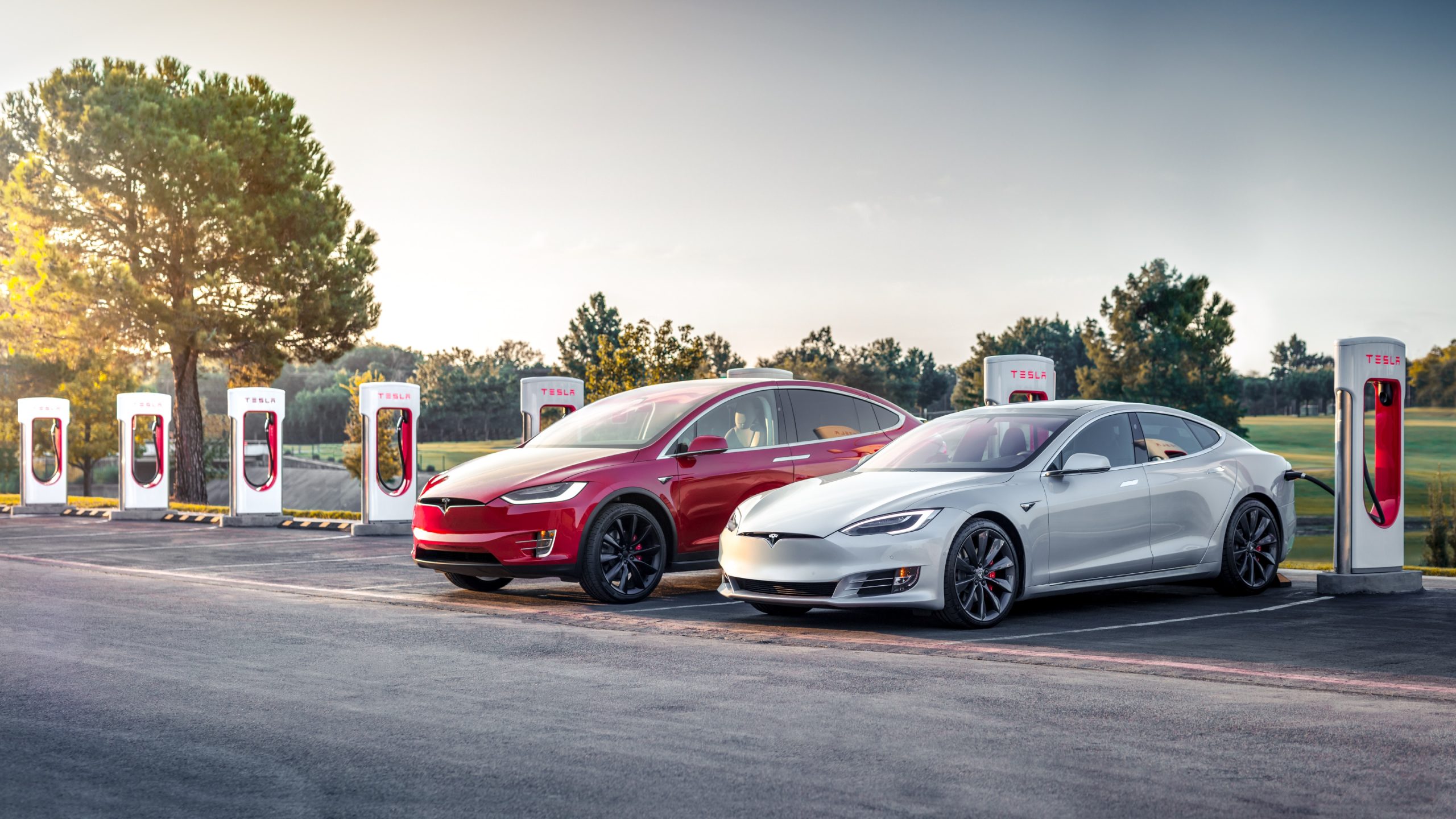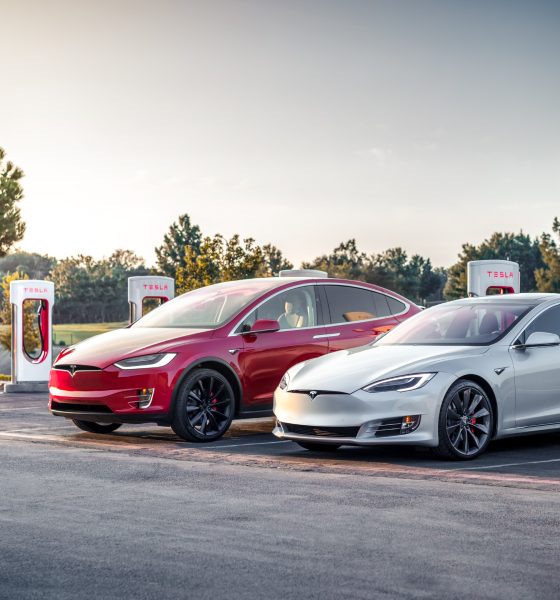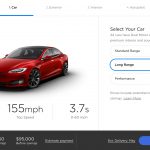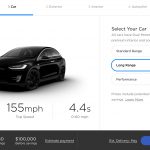

News
Tesla updates Model S, X: 370-mi range, faster charging, adaptive suspension
Rumors that a Tesla Model S and Model X refresh was arriving this year have been partially confirmed, with the electric carmaker announcing Tuesday afternoon that its flagship vehicles have been updated to use a completely new and highly-efficient drivetrain design, along with a new adaptive suspension.
Model S Long Range will have an industry leading 370-mile range per single charge, while Model X will boast a 325-mile range per charge. Tesla notes that the range increase is due in large part to a new drive unit design that leverages an optimized permanent magnet motor, improved cooling, bearings, and new gear design to achieve greater than 93% efficiency. The end result is improved range from the same battery cells that are currently being used in the Model S and Model X 100 kWh pack.
By improving drivetrain efficiency, Tesla has been able to effectively increase range by more than 10%. By improving the flow of energy out of the battery and back in through regenerative braking, Tesla was also able to further improve acceleration in the Model S and Model X.
“In addition to adding range, power and torque increases significantly across all Model S and Model X variants, improving 0-60 mph times for our Long Range and Standard Range models,” notes Tesla in its blog post.
In addition, Model S and Model X is now capable of recharging at a 50% faster rate from the help of new updates, including the more efficient drivetrain design. Similar to Tesla Model 3’s ability to charge at 1,000 miles per hour from Supercharger V3 when at a 250 kW max power output, Model S and Model X will be able to achieve 200 kW. It’s important to note that Tesla’s flagship vehicles will be able to charge at a faster rate from the same battery pack, while Model 3 utilizes a newer generation 2170 cylindrical cell with higher energy density than the Model S and Model X.
All Model S and Model X will now come with an upgraded air suspension system that uses software intelligence to adapt to various driving and road conditions.
“Unlike other manufacturers, our suspension software is developed completely in-house, using a predictive model to anticipate how the damping will need to be adjusted based on the road, speed, and other vehicle and driver inputs,” says Tesla, adding “The system constantly adapts by sensing the road and adjusting for driver behavior, automatically softening for more pronounced road inputs and firming for aggressive driving.”
In line with Tesla’s ability to constantly add new features to a vehicle and improve its performance through over the air software updates, Tesla’s new Fully Adaptive Suspension will continuously improve over time as new software is rolled out.
For performance enthusiast who’s an existing Model S or Model X owner, Tesla will be offering the $20k Ludicrous Mode upgrade for free on the purchase of a new Performance Model S or Performance Model X.
Details of the latest Model S and Model X update, including the addition of a Standard Range variant can be found in Tesla’s blog post. We’ve included it in its entirety below.
The Longest-Range Electric Vehicle Now Goes Even Farther
For more than a decade, Tesla engineers have been obsessed with making the world’s most efficient electric vehicles. As a result, Tesla vehicles already travel farther on a single charge than any other production EV on the market. Today, we’re making changes to Model S and Model X that allow them to travel unprecedented distances without needing to recharge, beating our own record for the longest-range production EVs on the road. And we’ve accomplished this without increasing the cars’ battery size, proving that our expertise in system-level design can make our cars dramatically more efficient.
Beginning today, Model S and Model X now come with an all-new drivetrain design that increases each vehicle’s range substantially, achieving a landmark 370 miles and 325 miles on the EPA cycle for Model S and Model X Long Range, respectively. Using the same 100 kWh battery pack, these design and architecture updates will allow drivers to travel farther than ever before, charging less frequently and getting more range out of every dollar spent on charging.
We’re also introducing a brand-new adaptive suspension system for Model S and Model X, along with a few other improvements for the best range, acceleration, and ride comfort ever, plus a Ludicrous Mode upgrade for our most loyal customers. Here’s what’s new:
More Efficient Design
All Model S and X vehicles now benefit from Tesla’s latest generation of drive unit technology, which combines an optimized permanent magnet synchronous reluctance motor, silicon carbide power electronics, and improved lubrication, cooling, bearings, and gear designs to achieve greater than 93% efficiency. Pairing a permanent magnet motor in the front with an induction motor in the rear enables unparalleled range and performance at all times. The net effect is a more than 10% improvement in range, with efficiency improvements in both directions as energy flows out of the battery during acceleration and back into the battery through regenerative braking. In addition to adding range, power and torque increases significantly across all Model S and Model X variants, improving 0-60 mph times for our Long Range and Standard Range models.
Faster Charging
Paired with the new more efficient drivetrain design, Model S and Model X are now capable of achieving 200 kW on V3 Superchargers and 145 kW on V2 Superchargers. Together, these improvements enable our customers to recharge their miles 50% faster.
Fully Adaptive Suspension
We’ve also upgraded our air suspension system for Model S and Model X with fully-adaptive damping, giving it an ultra-cushioned feel when cruising on the highway or using Autopilot, and a responsive, exhilarating confidence during dynamic driving. Unlike other manufacturers, our suspension software is developed completely in-house, using a predictive model to anticipate how the damping will need to be adjusted based on the road, speed, and other vehicle and driver inputs. The system constantly adapts by sensing the road and adjusting for driver behavior, automatically softening for more pronounced road inputs and firming for aggressive driving. We’ve also improved the leveling of the system while cruising, keeping the car low to optimize aerodynamic drag. As with all of Tesla’s in-house software, the adaptive suspension can receive over-the-air updates, allowing us to enable all Model S and Model X customers to have the most advanced suspension technology at all times.
Constant Refinement
To complement these changes, we’ve also re-engineered several other components of Model S and Model X in keeping with our philosophy of continuous improvement. These updates include new wheel bearings and a few new tire designs for certain variants to improve range, ride, and steering. While these changes may seem minor, together they have a meaningful impact when it comes to EV design.
In addition to our Long Range and Performance variants, we’re also re-introducing a lower entry price for Model S and Model X by bringing back our Standard Range option, now available for an even greater value with the new drivetrain and suspension updates. We also want to emphasize the critical impact each of our early Tesla owners has had on advancing our mission, so as a thank you, all existing Model S and Model X owners who wish to purchase a new Model S or Model X Performance car will get the Ludicrous Mode upgrade, a $20,000 value, at no additional charge.
These changes will go into production at our factory in Fremont, California this week, and can be ordered today at Tesla.com.

Elon Musk
Starlink achieves major milestones in 2025 progress report
Starlink wrapped up 2025 with impressive growth, adding more than 4.6 million new active customers and expanding service to 35 additional countries, territories, and markets.

Starlink wrapped up 2025 with impressive growth, adding more than 4.6 million new active customers and expanding service to 35 additional countries, territories, and markets. The company also completed deployment of its first-generation Direct to Cell constellation, launching over 650 satellites in just 18 months to enable cellular connectivity.
SpaceX highlighted Starlink’s impressive 2025 progress in an extensive report.
Key achievements from Starlink’s 2025 Progress
Starlink connected over 4.6 million new customers with high-speed internet while bringing service to 35 more regions worldwide in 2025. Starlink is now connecting 9.2 million people worldwide. The service achieved this just weeks after hitting its 8 million customer milestone.
Starlink is now available in 155 markets, including areas that are unreachable by traditional ISPs. As per SpaceX, Starlink has also provided over 21 million airline passengers and 20 million cruise passengers with reliable high-speed internet connectivity during their travels.
Starlink Direct to Cell
Starlink’s Direct to Cell constellation, more than 650 satellites strong, has already connected over 12 million people at least once, marking a breakthrough in global mobile coverage.
Starlink Direct to Cell is currently rolled out to 22 countries and 6 continents, with over 6 million monthly customers. Starlink Direct to Cell also has 27 MNO partners to date.
“This year, SpaceX completed deployment of the first generation of the Starlink Direct to Cell constellation, with more than 650 satellites launched to low-Earth orbit in just 18 months. Starlink Direct to Cell has connected more than 12 million people, and counting, at least once, providing life-saving connectivity when people need it most,” SpaceX wrote.
News
Tesla Giga Nevada celebrates production of 6 millionth drive unit
To celebrate the milestone, the Giga Nevada team gathered for a celebratory group photo.

Tesla’s Giga Nevada has reached an impressive milestone, producing its 6 millionth drive unit as 2925 came to a close.
To celebrate the milestone, the Giga Nevada team gathered for a celebratory group photo.
6 million drive units
The achievement was shared by the official Tesla Manufacturing account on social media platform X. “Congratulations to the Giga Nevada team for producing their 6 millionth Drive Unit!” Tesla wrote.
The photo showed numerous factory workers assembled on the production floor, proudly holding golden balloons that spelled out “6000000″ in front of drive unit assembly stations. Elon Musk gave credit to the Giga Nevada team, writing, “Congrats on 6M drive units!” in a post on X.
Giga Nevada’s essential role
Giga Nevada produces drive units, battery packs, and energy products. The facility has been a cornerstone of Tesla’s scaling since opening, and it was the crucial facility that ultimately enabled Tesla to ramp the Model 3 and Model Y. Even today, it serves as Tesla’s core hub for battery and drivetrain components for vehicles that are produced in the United States.
Giga Nevada is expected to support Tesla’s ambitious 2026 targets, including the launch of vehicles like the Tesla Semi and the Cybercab. Tesla will have a very busy 2026, and based on Giga Nevada’s activities so far, it appears that the facility will be equally busy as well.
News
Tesla Supercharger network delivers record 6.7 TWh in 2025
The network now exceeds 75,000 stalls globally, and it supports even non-Tesla vehicles across several key markets.

Tesla’s Supercharger Network had its biggest year ever in 2025, delivering a record 6.7 TWh of electricity to vehicles worldwide.
To celebrate its busy year, the official @TeslaCharging account shared an infographic showing the Supercharger Network’s growth from near-zero in 2012 to this year’s impressive milestone.
Record 6.7 TWh delivered in 2025
The bar chart shows steady Supercharger energy delivery increases since 2012. Based on the graphic, the Supercharger Network started small in the mid-2010s and accelerated sharply after 2019, when the Model 3 was going mainstream.
Each year from 2020 onward showed significantly more energy delivery, with 2025’s four quarters combining for the highest total yet at 6.7 TWh.
This energy powered millions of charging sessions across Tesla’s growing fleet of vehicles worldwide. The network now exceeds 75,000 stalls globally, and it supports even non-Tesla vehicles across several key markets. This makes the Supercharger Network loved not just by Tesla owners but EV drivers as a whole.
Resilience after Supercharger team changes
2025’s record energy delivery comes despite earlier 2024 layoffs on the Supercharger team, which sparked concerns about the system’s expansion pace. Max de Zegher, Tesla Director of Charging North America, also highlighted that “Outside China, Superchargers delivered more energy than all other fast chargers combined.”
Longtime Tesla owner and FSD tester Whole Mars Catalog noted the achievement as proof of continued momentum post-layoffs. At the time of the Supercharger team’s layoffs in 2024, numerous critics were claiming that Elon Musk was halting the network’s expansion altogether, and that the team only remained because the adults in the room convinced the juvenile CEO to relent.
Such a scenario, at least based on the graphic posted by the Tesla Charging team on X, seems highly implausible.









